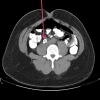Retroperitoneal Pseudoaneurysm Mimicking Ureteral Calculus: Pitfalls in Diagnosis
- PMID: 29226048
- PMCID: PMC5722636
- DOI: 10.7759/cureus.1758
Retroperitoneal Pseudoaneurysm Mimicking Ureteral Calculus: Pitfalls in Diagnosis
Abstract
Arterial aneurysms (AA) can be classified as true aneurysms, characterized by the persistence of all three layers of the arterial wall with progressive dilation and wall thinning; arterial pseudoaneurysms (APAs) are characterized by a tear in the vessel wall and a periarterial hematoma formation. They could occur due to a visceral, retroperitoneal, or peripheral origin. Most AA/APA are usually found incidentally, and it is imperative to be vigilant in order to diagnose and manage them due to their potentially life-threatening complications. We present a case of a 35-year-old woman presenting with right-sided abdominal pain mimicking renal colic with an initial misdiagnosis of ureteral calculus. Post-cystoscopy, a misdiagnosis was confirmed, and subsequently, the patient had a right retroperitoneal mass excision. The histopathology report concluded the calcified retroperitoneal mass to be pseudoaneurysm. Such pitfalls in diagnosis are essential to be shared with the larger medical community for increased vigilance and optimal management of pseudoaneurysms.
Keywords: hematoma; misdiagnosis; pseudoaneurysm; ureteral calculus.
Conflict of interest statement
The authors have declared that no competing interests exist.
Figures



References
-
- Visceral artery aneurysm: risk factor analysis and therapeutic opinion. Huang YK, Hsieh HC, Tsai FC, et al. Eur J Vasc Endovasc Surg. 2007;33:293–301. - PubMed
-
- Visceral and peripheral arterial pseudoaneurysms. Sueyoshi E, Sakamoto I, Nakashima K, et al. AJR Am J Roentgenol. 2005;185:741–749. - PubMed
-
- Review of visceral aneurysms and pseudoaneurysms. Lu M, Weiss C, Fishman EK, et al. J Comput Assist Tomogr. 2015;39:1–6. - PubMed
-
- Management of true visceral artery aneurysms in 31 cases. Regus S, Lang W. J Visc Surg. 2016;153:347–352. - PubMed
Publication types
LinkOut - more resources
Full Text Sources
Other Literature Sources
